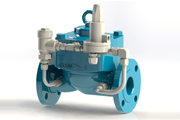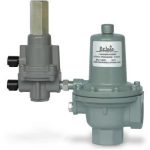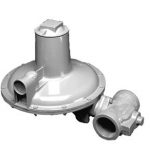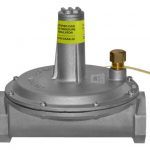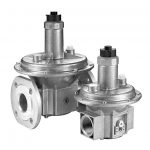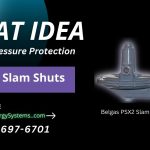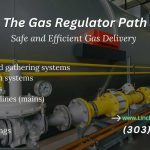Natural Gas Pressure Regulators: Types and Selection Tips
Delve into the different types of natural gas pressure regulators in the natural gas distribution network: appliance regulators, line pressure regulators, service regulators, pilot-operated regulators, and pressure regulators. The practical tips for selecting them and their functions related to the distribution mains will equip you with the necessary knowledge, making you feel confident in your decision-making process.
Natural Gas Distribution Mains
The distribution system delivers natural gas from the transmission system to end-users. Unlike the transmission system, which transports high volumes of natural gas at high pressures, the distribution system runs through cities and other areas at much lower pressures and through smaller pipelines (typically 2 to 24 inches). Pressures normally range near the transmission line from 60 psi to 1 psi as it reaches houses or businesses.
This pressure is significant because the appliances used in a house, business, or plant do not accommodate high gas pressure. The closer the pipe gets to the end user, the smaller it becomes and the lower the pressure. Most commonly, distribution mains operate at ten psi or more; the last pressure reduction to 1/4 psi occurs just before the end users’ meters.
Regulators play a vital role in the natural gas distribution network, ensuring safe gas pressure levels for customers. Whether for residential, commercial, or larger industrial customers, regulators adjust the system’s pressures to acceptable levels for all end users.
Supply Main
The supply main, a key component of the natural gas distribution network, runs between the interconnection with the transmission system and the feeder mains. It can also be directly connected to a large industrial customer or power plant, with typical pressures ranging from 150 to 400 psi.
Feeder Main
The feeder main connects the supply main at a regulator station, reducing the supply main’s high pressure. The feeder main is the connection between the supply main and the distribution main. Typical pressures for feeder mains range from 26 to 60 psi.
Distribution Main
The distribution main runs throughout the service area, bringing gas to areas of mass consumption with pressures ranging from 1 to 25 psi.
Service Line
The service line is a much smaller line that connects a home or business with the distribution main. The main may run underneath a street or sidewalk and have pressures around ¼ to 1 psi, but they may be higher for larger end users.
Fuel Line
The fuel line is the final connection to a customer’s appliances or any line beyond the LDC (local distribution company) meter that runs into a house or business. The property owner owns and maintains this and typically operates at a pressure of ¼ psi or less.
5 Types of Natural Gas Pressure Regulators
The gas distribution network has five common types of natural gas pressure regulators.
1. Pressure Regulators
Pressure regulators control pressure in specific sections of a natural gas pipe system, including the supply, feeder, distribution, and service mains. They are used strategically to maintain safety and efficiency.
When selecting a pressure regulator, understand the desired outlet pressure to determine the correct regulator. When considering a pressure regulator, always include spring requirements, casing pressure rating, and orifice size.
2. Pilot-Operated Regulators
Pilot-operated regulators are ideal for high-capacity scenarios where maintaining high pressure with minimal outlet pressure drop is crucial. They are used when precision matters, such as in large-scale natural gas systems. These regulators work by combining two independent regulators with a smaller pilot.
For optimal performance, the user must ensure precise adjustments.
3. Service Regulator
A service regulator is typically installed outside the building, whether a home, commercial, or industrial building, near the gas meter. It reduces the gas pressure from the service line (gas supply from your gas distributor) to a safe and usable pressure for household or industrial appliances. It ensures consistent gas pressure within the building.
When selecting a service regulator, consider factors like inlet pressure, outlet pressure, and capacity requirements.
4. Line Pressure Regulator
Line Pressure Regulators are usually installed inside the building, closer to the point of use (e.g., near appliances or equipment). They further regulate the gas pressure to match specific appliance requirements, fine-tuning the pressure for individual appliances.
Choose line pressure regulators based on the appliance load, flow rate, and desired outlet pressure.
5. Appliance Regulators
Appliance regulators are the last regulators in the line and are in residential, commercial, and industrial gas equipment. They handle precise flows for pilot loads in smaller appliances and more significant flows for main burners in industrial equipment.
When choosing appliance regulators, it’s practical to consider your specific application needs, including indoor or outdoor use, ventless options, and relief valves.
Remember, safety is paramount. Properly selected regulators ensure efficient gas flow while safeguarding against dangerous pressure levels.
Linc Energy Systems distributes the finest brands of natural gas regulators, including Honeywell (formerly Gorter, RMG, American Meter), Belgas, Itron (Dresser), Maxitrol, and Dungs.
If you want to learn more about selecting or sizing a regulator, message us or call (303) 697-6701 today for assistance.
See our Regulator Cross Reference Guide.
